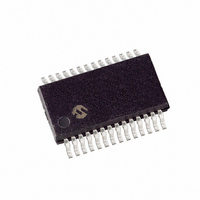DSPIC33FJ12GP202-I/SS Microchip Technology, DSPIC33FJ12GP202-I/SS Datasheet - Page 47

DSPIC33FJ12GP202-I/SS
Manufacturer Part Number
DSPIC33FJ12GP202-I/SS
Description
IC DSPIC MCU/DSP 12K 28SSOP
Manufacturer
Microchip Technology
Series
dsPIC™ 33Fr
Datasheets
1.DSPIC33FJ12GP201-ISO.pdf
(90 pages)
2.DSPIC33FJ12GP201-ISO.pdf
(249 pages)
3.DSPIC33FJ12GP201-ISO.pdf
(12 pages)
4.DSPIC33FJ12GP202-IML.pdf
(242 pages)
Specifications of DSPIC33FJ12GP202-I/SS
Core Processor
dsPIC
Core Size
16-Bit
Speed
40 MIPs
Connectivity
I²C, IrDA, SPI, UART/USART
Peripherals
Brown-out Detect/Reset, POR, PWM, WDT
Number Of I /o
21
Program Memory Size
12KB (12K x 8)
Program Memory Type
FLASH
Ram Size
1K x 8
Voltage - Supply (vcc/vdd)
3 V ~ 3.6 V
Data Converters
A/D 10x12b
Oscillator Type
Internal
Operating Temperature
-40°C ~ 85°C
Package / Case
28-SSOP
Core Frequency
40MHz
Core Supply Voltage
2.75V
Embedded Interface Type
I2C, JTAG, SPI, UART
No. Of I/o's
21
Flash Memory Size
12KB
Supply Voltage Range
3V To 3.6V
Package
28SSOP
Device Core
dsPIC
Family Name
dsPIC33
Maximum Speed
40 MHz
Operating Supply Voltage
3.3 V
Data Bus Width
16 Bit
Number Of Programmable I/os
21
Interface Type
I2C/SPI/UART
On-chip Adc
10-chx12-bit
Number Of Timers
3
Lead Free Status / RoHS Status
Lead free / RoHS Compliant
Eeprom Size
-
Lead Free Status / RoHS Status
Lead free / RoHS Compliant, Lead free / RoHS Compliant
- DSPIC33FJ12GP201-ISO PDF datasheet
- DSPIC33FJ12GP201-ISO PDF datasheet #2
- DSPIC33FJ12GP201-ISO PDF datasheet #3
- DSPIC33FJ12GP202-IML PDF datasheet #4
- Current page: 47 of 249
- Download datasheet (4Mb)
4.4.3
Modulo Addressing can be applied to the EA
calculation associated with any W register.
Address boundaries check for addresses equal to:
• The upper boundary addresses for incrementing
• The lower boundary addresses for decrementing
It is important to realize that the address boundaries
also check for addresses less than or greater than
these addresses. Address changes can, therefore,
jump beyond boundaries and still be adjusted correctly.
4.5
Bit-Reversed Addressing mode is intended to simplify
data re-ordering for radix-2 FFT algorithms. It is
supported by the X AGU for data writes only.
The modifier, which can be a constant value or register
contents, is regarded as having its bit order reversed. The
address source and destination are kept in normal order.
Thus, the only operand requiring reversal is the modifier.
© 2009 Microchip Technology Inc.
buffers
buffers
Note:
Bit-Reversed Addressing
MODULO ADDRESSING
APPLICABILITY
The modulo corrected effective address is
written back to the register only when
Pre-Modify or Post-Modify Addressing
mode is used to compute the effective
address. When an address offset (such as
[W7+W2]) is used, Modulo Address cor-
rection is performed, but the contents of
the register remain unchanged.
Preliminary
dsPIC33FJ12GP201/202
4.5.1
Bit-Reversed Addressing mode is enabled in any of
these situations:
• BWM bits (W register selection) in the MODCON
• The BREN bit is set in the XBREV register
• The addressing mode used is Register Indirect
If the length of a bit-reversed buffer is M = 2
the last ‘N’ bits of the data buffer start address must
be zeros.
XB<14:0> is the Bit-Reversed Address modifier, or
‘pivot point,’ which is typically a constant. In the case of
an FFT computation, its value is equal to half of the FFT
data buffer size.
When enabled, Bit-Reversed Addressing is executed
only for Register Indirect with Pre-Increment or
Post-Increment Addressing, and word-sized data
writes. It will not function for any other addressing
mode or for byte-sized data, and normal addresses are
generated instead. When Bit-Reversed Addressing is
active, the W Address Pointer is always added to the
address modifier (XB), and the offset associated with
the Register Indirect Addressing mode is ignored. In
addition, as word-sized data is a requirement, the LSb
of the EA is ignored (and always clear).
If Bit-Reversed Addressing has already been enabled
by setting the BREN (XBREV<15>) bit, a write to the
XBREV register should not be immediately followed by
an indirect read operation using the W register that has
been designated as the bit-reversed pointer.
register are any value other than ‘15’ (the stack
cannot be accessed using Bit-Reversed
Addressing)
with Pre-Increment or Post-Increment
Note:
Note:
BIT-REVERSED ADDRESSING
IMPLEMENTATION
All bit-reversed EA calculations assume
word-sized data (LSB of every EA is
always clear). The XB value is scaled
accordingly to generate compatible (byte)
addresses.
Modulo Addressing and Bit-Reversed
Addressing
together. If an application attempts to do so,
Bit-Reversed Addressing will assume prior-
ity when active for the X WAGU, and X
WAGU Modulo Addressing will be dis-
abled. However, Modulo Addressing will
continue to function in the X RAGU.
should
not
DS70264D-page 45
be
enabled
N
bytes,
Related parts for DSPIC33FJ12GP202-I/SS
Image
Part Number
Description
Manufacturer
Datasheet
Request
R

Part Number:
Description:
IC, DSC, 16BIT, 12KB, 40MHZ, 3.6V, DIP28
Manufacturer:
Microchip Technology
Datasheet:

Part Number:
Description:
Manufacturer:
Microchip Technology Inc.
Datasheet:

Part Number:
Description:
Manufacturer:
Microchip Technology Inc.
Datasheet:

Part Number:
Description:
Manufacturer:
Microchip Technology Inc.
Datasheet:

Part Number:
Description:
Manufacturer:
Microchip Technology Inc.
Datasheet:

Part Number:
Description:
Manufacturer:
Microchip Technology Inc.
Datasheet:

Part Number:
Description:
Manufacturer:
Microchip Technology Inc.
Datasheet:

Part Number:
Description:
Manufacturer:
Microchip Technology Inc.
Datasheet:

Part Number:
Description:
Manufacturer:
Microchip Technology Inc.
Datasheet:










